Welcome to our blog, where we dive into the fascinating world of Red Wattle Hogs! These unique and captivating creatures have a rich history and many intriguing characteristics. Originating in the United States, Red Wattle Hogs have gained popularity for their impressive size and distinctive physical features.
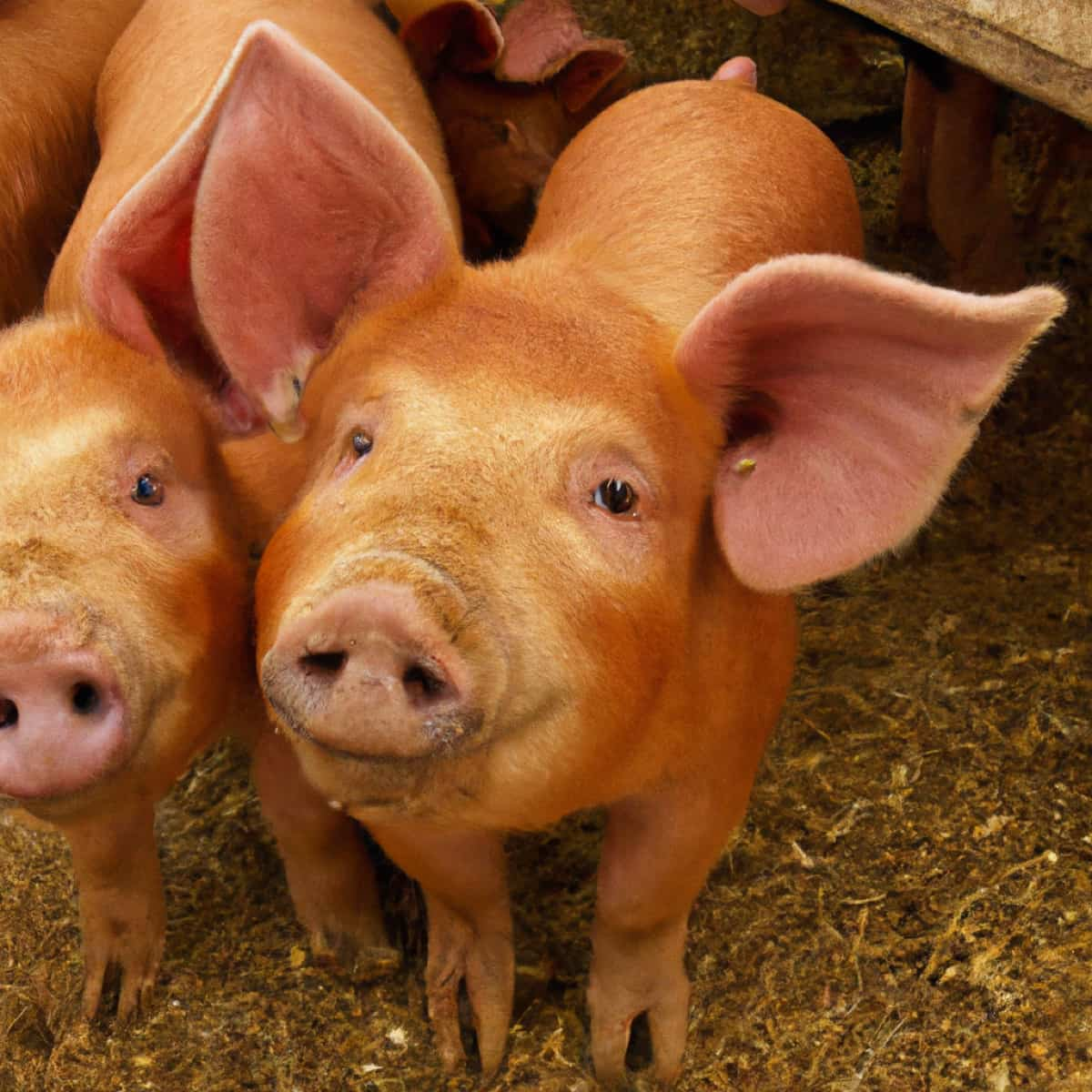
With their reddish coat and prominent wattles hanging from their jowls, they are truly a sight to behold. This article delves into their size, physical characteristics, and the pros and cons of raising these amazing animals. So, let’s jump right in and uncover the wonders of Red Wattle Hogs!
Red Wattle Hog Facts
Introduction to Red Wattle Hog Breed
The Red Wattle Hog is a fascinating breed of domestic pig that originated in the United States. Known for its red color and unique wattles or tassels, this breed has been on the threatened list of the American Livestock Breeds Conservancy (ALBC). Although the early history of the Red Wattle Hog remains to be seen, we can trace its modern lineage back to animals discovered in East Texas during the late 1960s and early 1970s. It was H. C. Wengler who kickstarted the “Wengler Red Waddle” line by cross-breeding two-wattled red sows with a Duroc boar.
Red Wattle Hog Origin and History
The origins and history of the Red Wattle Hog are shrouded in the modern breed and can be traced back to the discovery of animals in East Texas during the late 1960s and early 1970s. H. C. Wengler played a significant role in starting the “Wengler Red Waddle” line by cross-breeding two-wattled red sows with a Duroc boar. Another line, known as the Timberline, was established about 20 years later by Robert Prentice, who crossed his Timberlines with Wengler’s line to create the Endow Farm Wattle Hogs.
In the 1980s, there were three breed registries but no central association. By 1999, the American Livestock Breeds Conservancy reported only 42 breeding animals among six breeders. However, since September 2012, the Red Wattle Hog Association has maintained the breed’s pedigree book. Slow Food USA even lists the Red Wattle Hog in the Ark of Taste. An impressive individual named Reggie broke a record at the Iowa State Fair in 2012, weighing 1,335 pounds.
In case you missed it: Pietrain Pig Facts: Origin, Size, Physical Characteristics, Pros, and Cons
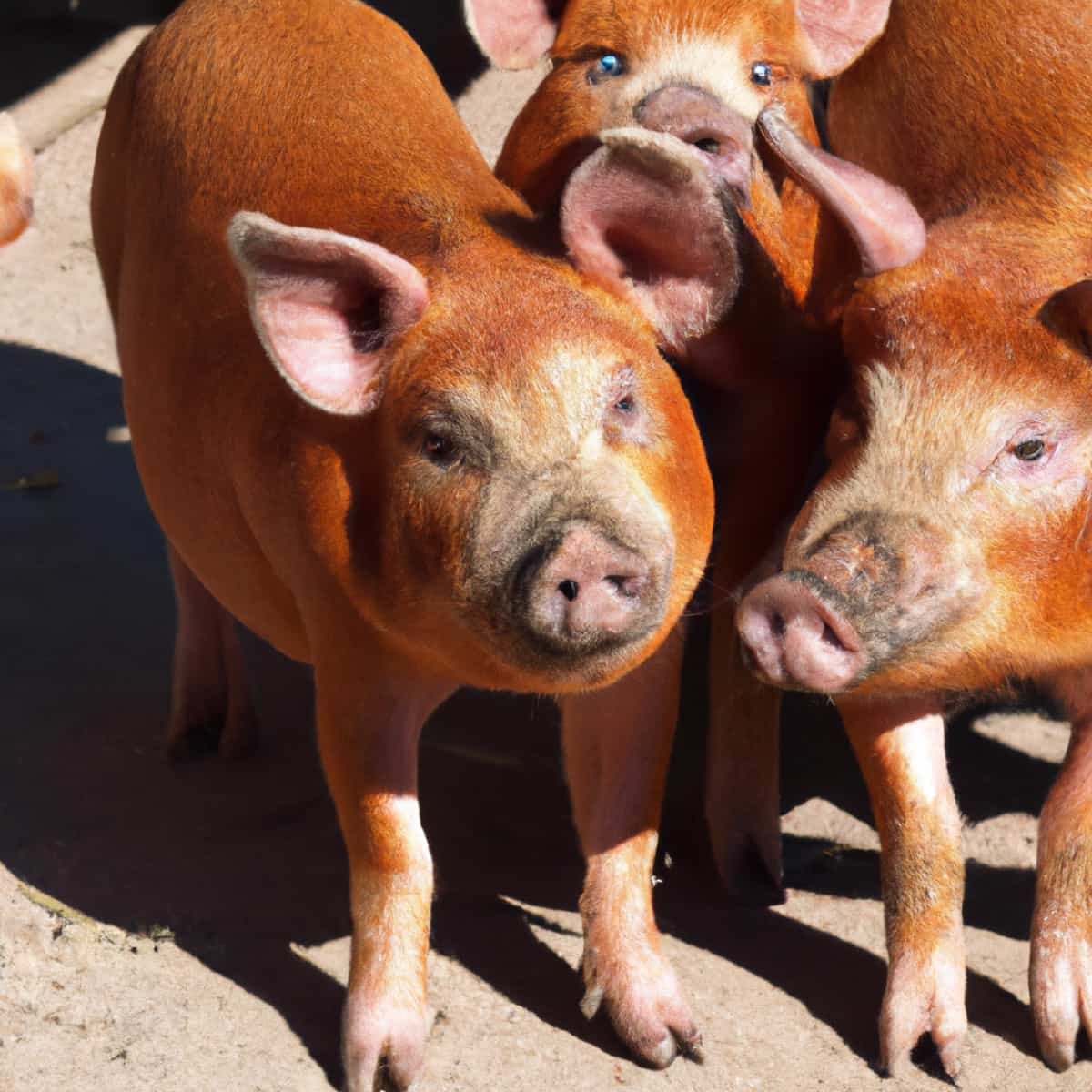
Red Wattle Hog Size and Weight
Red Wattle Hogs come in different sizes based on their gender. Adult males can weigh around 750 pounds (340 kilograms), while females tend to be slightly lighter at 550 pounds (249 kilograms). These hogs average stand at approximately 4 feet (120 centimeters). When they reach full maturity, Red Wattle Hogs can grow up to 8 feet in length and stand 4 feet tall.
Physical Characteristics of Red Wattle Hogs
- Coat and Wattles: Red Wattle Hogs are easily recognized by their red coats and distinctive wattles hanging from their jowls.
- Weight and Size: These hogs typically weigh between 800 to 1,000 pounds (360 to 450 kilograms). However, larger individuals can reach up to 1,200 pounds (540 kilograms) in weight. They can grow to be approximately 4 feet (120 centimeters) in height and 8 feet (240 centimeters) in length.
- Hair: Red Wattle Hogs have hair in various shades of red, with some individuals displaying an almost black color.
- Conservation Status: This breed is considered threatened, highlighting the need for conservation efforts to preserve its population.
- Other Names: Red Wattle Hogs are also known as Red Wattle pigs, referring to their distinctive wattles.
- Country of Origin: The United States is the country where the Red Wattle Hog breed originated.
- Reproduction: Red Wattle Hogs typically have 7 to 12 piglets per litter, highlighting their productive breeding capabilities.
- Growth and Adaptability: These hogs have a fast growth rate, forage well, and exhibit hardiness. They are also known for their mild temperament and disease resistance, making them suitable for extensive management practices.
- Mothering Ability and Meat Quality: Red Wattle Hogs are recognized for their excellent mothering skills. Additionally, they are renowned for producing high-quality marbled and tender meat, adding to their appeal as livestock breed.
Pros of Raising Red Wattle Hogs
Raising Red Wattle Hogs offers the benefits of high-quality meat, a docile temperament, suitability for beginners, a potentially long lifespan, and a consistent gestation period for breeding management.
- Meat: Red Wattle Hogs are known for their high-quality meat, which is marbled and tender, making them a desirable choice for meat production.
- Temperament: These hogs have a docile temperament, making them easier to handle and manage, especially for beginners in pig farming.
- Experience Level: Red Wattle Hogs are well-suited for beginners in livestock farming, as they are relatively easy to raise and care for.
- Longevity: On average, Red Wattle Hogs have a 9 to 15 years lifespan. However, if raised as pets rather than for meat, their life expectancy can extend to 20 years.
- Gestation Period: The gestation period for Red Wattle pigs is around 114 days, or approximately three months, three weeks, and three days, providing a predictable breeding cycle.
In case you missed it: Successful Pig Farm Management and Operational Strategies: A Complete Guide
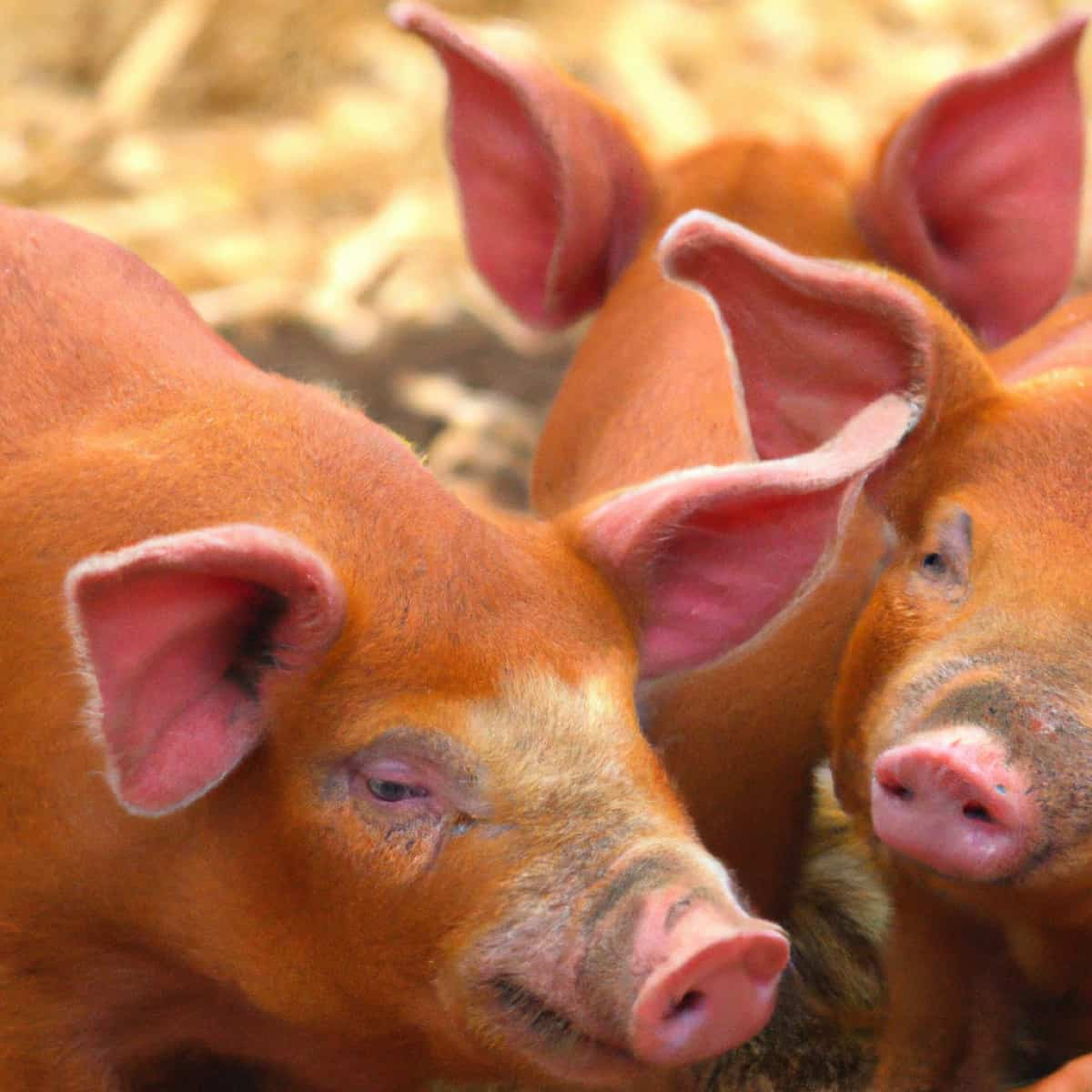
Cons of Raising Red Wattle Hogs
The cons of raising Red Wattle Hogs include the need for ample space, higher feeding costs, limited availability of breeding stock due to their threatened status, potential breeding challenges due to their size, and the requirement for proper care and maintenance to ensure their well-being.
Unique Features of the Red Wattle Hog Breed
The Red Wattle Hog breed stands out with its distinctive wattles, red coat, high-quality meat, adaptability to different environments, and strong foraging ability. These unique features contribute to the breed’s appeal and popularity.
- Wattles: One of the most distinctive characteristics of Red Wattle Hogs is their prominent wattles, which are fleshy appendages hanging from their jowls. These wattles can vary in size and shape, adding to the breed’s visual appeal.
- Red Coat: As their name suggests, Red Wattle Hogs have a coat that ranges in various shades of red. Some individuals may even exhibit a coloration that appears almost black.
- Meat Quality: Red Wattle Hogs are renowned for their high-quality meat. The meat is well-marbled, which contributes to its tenderness and flavor. It is sought after by chefs and consumers for its exceptional taste and texture.
- Adaptability: These hogs are known for their adaptability to different climates and management systems. They can thrive in various environments, including pasture-based and extensive production systems.
- Foraging Ability: Red Wattle Hogs have a natural inclination for foraging and can utilize pasture resources effectively. This characteristic makes them suitable for free-range or extensive management practices.
Red Wattle Hog Breed Traits and Temperament
- Color Variations: Red Wattle Hogs exhibit a range of red shades, from light blond to nearly black, with consistent coloration throughout the animal. Small black spots on the belly may be acceptable for registration.
- Tusks and Temperament: While some boars may have impressive tusks, Red Wattle Hogs are generally docile.
- Hair Characteristics: The hair of Red Wattle Hogs can be either short and straight or long and wavy, adding to their visual variety.
- Physical Features: The breed displays clean and lean heads with slim, slightly curved noses. Their upright ears have drooping tips. They possess short-coupled bodies with slightly arched rumps.
- Mothering Abilities: Sows of the Red Wattle breed are excellent mothers, often farrowing 7 to 12 piglets and providing ample milk for their large litters.
- Size and Weight: Mature Red Wattle Hogs typically weigh 600 to 800 pounds, although they can reach sizes as large as 1,200.
- Hardiness and Rapid Growth: Red Wattle Hogs are known for their hardiness, adaptability to various climates, and rapid growth rate. They often reach full maturity by the age of three.
- Foraging and Feed Conversion: These hogs are active foragers and can obtain essential minerals from grazing, reducing the reliance on commercial feed. They have a high Feed Conversion Ratio (FCR), efficiently using feed resources.
- Meat Quality: Red Wattle Hogs produce well-marbled and flavorful meat, often described as similar in taste to beef.
In case you missed it: How to Build a Pig Pen for Backyard Farming: A Step-by-Step Guide
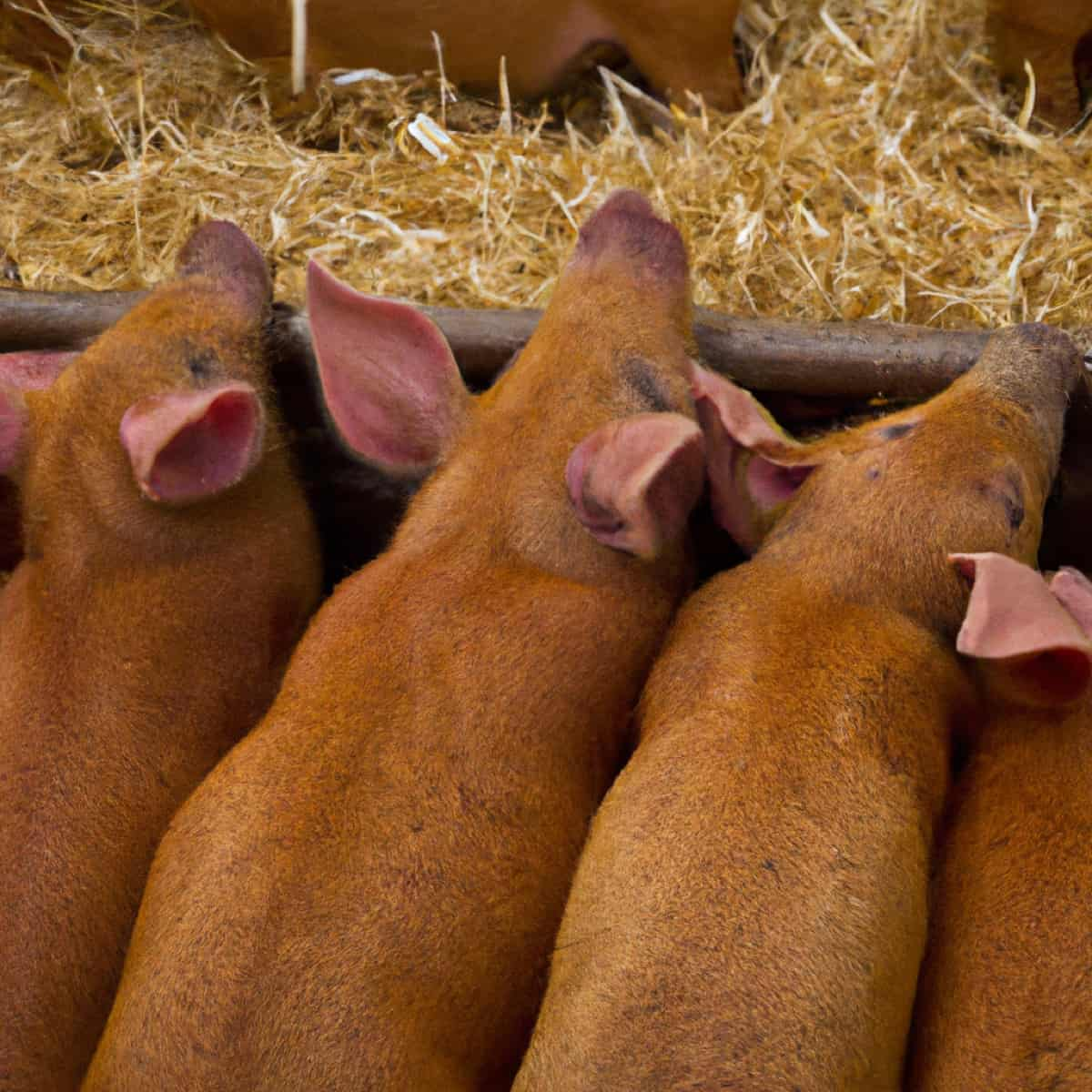
Red Wattle Hog Growth Rate and Maturity
Red Wattle Hogs demonstrate a rapid growth rate, reaching maturity in approximately three years. They experience significant weight gain, with preferred butcher weights between 300 to 325 pounds. Their impressive size, efficient feed conversion, and active foraging activity contribute to their growth and development.
- Growth Rate: Red Wattle Hogs are known for their fast growth. Scientific data indicates they can fully mature in as little as three years.
- Weight Gain: These hogs experience substantial weight gain during their growth phase. Breeders often prefer butcher weights ranging from 300 to 325 pounds, with hanging weights between 220 to 245 pounds.
- Size at Maturity: Red Wattle Hogs can reach impressive sizes when fully grown. They can measure up to 4 feet in height and 8 feet in length.
- Feed Conversion Efficiency: Red Wattle Hogs have a notable Feed Conversion Ratio (FCR), meaning they efficiently convert feed into body mass. This contributes to their rapid growth and development.
- Foraging Activity: Red Wattle Hogs are active foragers, utilizing grazing and other food sources effectively. This, combined with their efficient feed conversion, aids in their growth and development.
Red Wattle Hog Meat Quality and Flavor
- Marbling: The meat of Red Wattle Hogs is well-marbled, meaning it contains a good amount of intramuscular fat. This marbling contributes to its tenderness, juiciness, and flavor.
- Flavor Profile: Red Wattle Hog meat is often described as having a rich, succulent, and flavorful taste. It is known for its robust and distinctive pork flavor.
- Similarity to Beef: The meat of Red Wattle Hogs has been noted for its resemblance to beef in terms of taste and texture. This unique characteristic sets it apart from other pork varieties.
- Culinary Applications: The high-quality meat of Red Wattle Hogs is favored by chefs and culinary enthusiasts. It is well-suited for various cooking methods, including grilling, roasting, and smoking.
In case you missed it: Disease Prevention and Management in Commercial Pig Farms
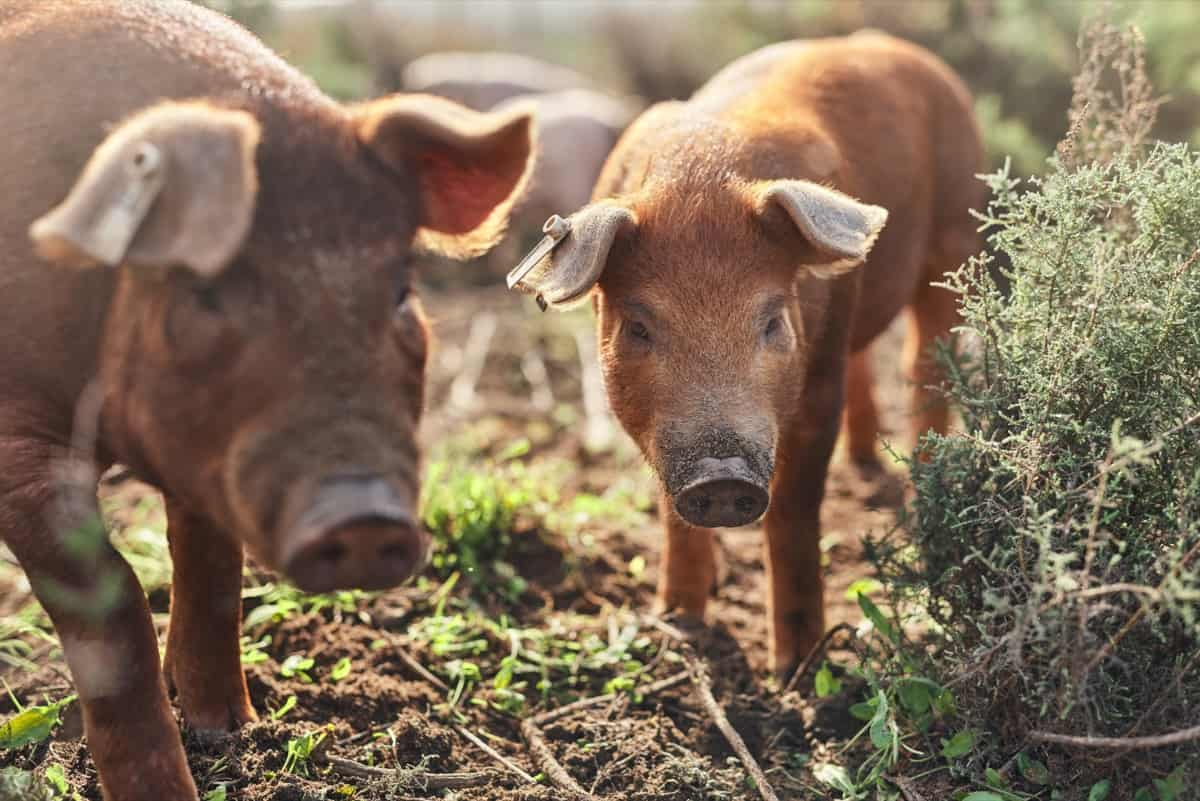
Red Wattle Hog Farming Benefits and Challenges
Benefits of Red Wattle Hog Farming
- Meat Quality: Red Wattle Hogs produce high-quality, well-marbled meat with a distinct flavor. Studies have shown that meat is tender, juicy, and often compared to beef in taste and texture.
- Foraging Ability: These hogs are efficient foragers, capable of utilizing grazing and natural food sources. This can reduce feeding costs and reliance on commercial feed, making them suitable for extensive management systems.
- Adaptability: Red Wattle Hogs are known for their hardiness and adaptability to different ranges of climates. They can thrive in both outdoor and pasture-based swine production systems.
- Mothering Ability: Sows of the breed exhibit excellent mothering skills, farrowing 7 to 12 piglets and providing abundant milk for their litters.
Challenges of Red Wattle Hog Farming
- Limited Availability: Red Wattle Hogs are considered a threatened breed, and it is challenging to find the breeding stock. This can limit the accessibility of the breed for farmers.
- Breeding Challenges: Due to their larger size, Red Wattle Hogs may experience difficulties with natural breeding. Assistance or artificial insemination may be required to ensure successful reproduction.
- Space and Feeding Costs: Red Wattle Hogs require ample space for physical activity and rooting behavior. Their larger appetite can also result in higher feeding costs than other pig breeds.
- Maintenance and Care: Proper care and maintenance, including shelter, fencing, and healthcare, are necessary to ensure the well-being and health of Red Wattle Hogs.
Red Wattle Hog Breeding and Reproduction
- Gestation Period: The gestation period for Red Wattle Hogs is approximately 114 days, equivalent to 3 months, three weeks, and three days.
- Litter Size: Sows of the breed typically have litter ranging from 7 to 12 piglets. They are known for their ability to provide ample milk for their offspring.
- Breeding Challenges: due to their larger size, Red Wattle Hogs may encounter difficulties with natural breeding. This often requires assistance or artificial insemination methods for successful reproduction.
- Breeding Age: Female Red Wattle Hogs generally reach sexual maturity around 6 to 10 months of age, while males become sexually mature around 7 to 10 months of age.
Red Wattle Hog Pig Farming Profitability
- Cost of Piglets: On average, a 30-pound Red Wattle piglet can cost approximately $150.
- Breeding Stock Prices: Breeding boars are typically priced around $300, while young sows can be around $400.
In case you missed it: Pig Waste Management and Sustainable Manure Utilization
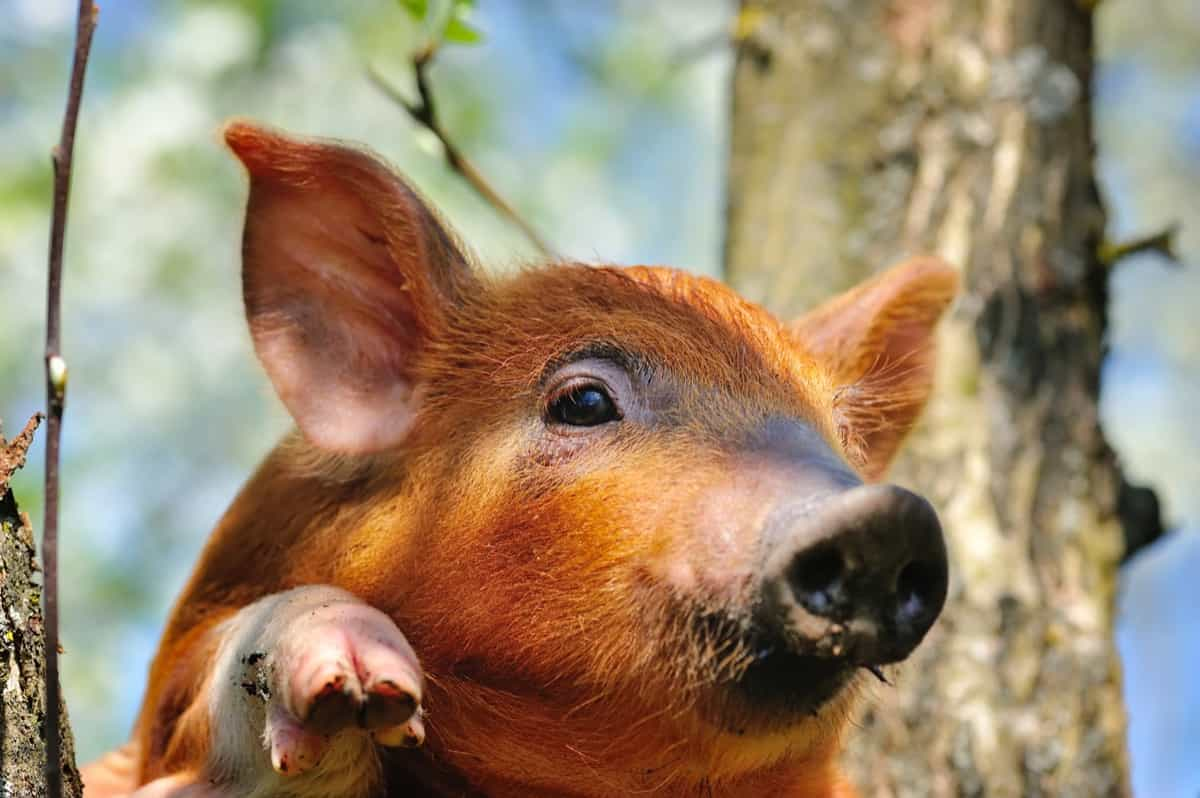
Conclusion
Red Wattle Hog is an American breed with a fascinating origin. They have a distinctive appearance, reaching significant size and weight. While they offer benefits like meat quality and foraging ability, challenges include limited availability and space requirements.
- Types of Pesticides Used in Agriculture: A Beginner’s Guide
- Economical Aquaculture: A Guide to Low-Budget Fish Farming
- 15 Common Planting Errors That Can Doom Your Fruit Trees
- How to Make Houseplants Bushy: Effective Tips and Ideas
- Innovative Strategies for Boosting Coconut Pollination and Yield
- Pollination Strategies for Maximum Pumpkin Yield
- The Complete Guide to Chicken Fattening: Strategies for Maximum Growth
- Natural Solutions for Tulip Problems: 100% Effective Remedies for Leaf and Bulb-Related Issues
- Revolutionizing Citrus Preservation: Towards a Healthier, Greener Future
- Natural Solutions for Peony Leaf and Flower Problems: 100% Effective Remedies
- Maximizing Profits with Avocado Contract Farming in India: A Comprehensive Guide
- Natural Solutions for Hydrangea Problems: 100% Effective Remedies for Leaf and Flowers
- The Ultimate Guide to Choosing the Perfect Foliage Friend: Bringing Life Indoors
- From Sunlight to Sustainability: 15 Ways to Use Solar Technology in Agriculture
- The Ultimate Guide to Dong Tao Chicken: Exploring from History to Raising
- The Eco-Friendly Makeover: How to Convert Your Unused Swimming Pool into a Fish Pond
- Mastering the Art of Delaware Chicken Farming: Essentials for Healthy Backyard Flocks
- 20 Best Homemade Fertilizers for Money Plant: DIY Recipes and Application Methods
- How to Craft a Comprehensive Free-Range Chicken Farming Business Plan
- Brighten Your Flock: Raising Easter Egger Chickens for Beauty and Bounty
- How to Optimize Your Poultry Egg Farm Business Plan with These Strategies
- Subsidy for Spirulina Cultivation: How Indian Government Schemes Encouraging Spirulina Farmers
- Ultimate Guide to Raising Dominique Chickens: Breeding, Feeding, Egg-Production, and Care
- Mastering the Art of Raising Jersey Giant Chickens: Care, Feeding, and More
- Ultimate Guide to Raising Legbar Chickens: Breeding, Farming Practices, Diet, Egg-Production
- How to Raise Welsummer Chickens: A Comprehensive Guide for Beginners
- How to Protect Indoor Plants in Winter: A Comprehensive Guide
- Ultimate Guide to Grow Bag Gardening: Tips, Tricks, and Planting Ideas for Urban Gardeners
- Guide to Lotus Cultivation: How to Propagate, Plant, Grow, Care, Cost, and Profit
- Agriculture Drone Subsidy Scheme: Government Kisan Subsidy, License, and How to Apply Online
- Ultimate Guide to Raising Araucana Chickens: Breed Profile, Farming Economics, Diet, and Care
- Bringing Hydroponics to Classroom: Importance, Benefits of Learning for School Students
- Ultimate Guide to Raising Polish Chickens: Breed Profile, Farming Economics, Diet, and Care
- Ultimate Guide to Raising Australorp Chickens: Profile, Farming Economics, Egg Production, Diet, and Care
- Silkie Chicken Farming: Raising Practices, Varieties, Egg Production, Diet, and Care
- Sussex Chicken Farming: Raising Practices, Varieties, Egg Production, Diet and Care